Burgtheater
The Burgtheater (German: [ˈbʊʁk.teˌaːtɐ]; literally:"Castle Theater" but alternatively translated as "(Imperial) Court Theater"), originally known as K.K. Theater an der Burg, then until 1918 as the K.K. Hofburgtheater, is the national theater of Austria in Vienna. It is the most important German-language theater and one of the most important theatres in the world.[1] The Burgtheater was opened in 1741 and has become known as "die Burg" by the Viennese population;[1] its theater company has created a traditional style and speech typical of Burgtheater performances.
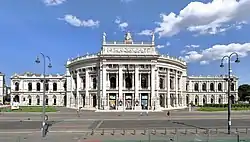 | |
| Former names |
|
|---|---|
| Address | Universitätsring 2 Vienna Austria |
| Coordinates | 48°12′37″N 16°21′41″E |
| Type | Theater |
| Opened | 14 March 1741 |
| Website | |
| burgtheater | |
History
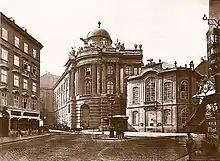
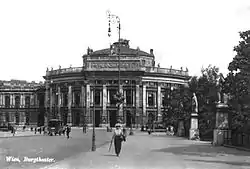
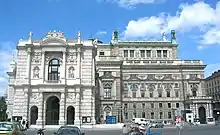
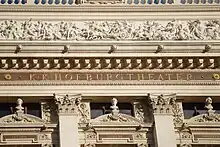
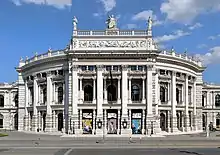
The original Burgtheater was set up in a tennis court (called a 'ball house' at the time) that the Roman-German king and later emperor Ferdinand I had built in 1540 in the lower pleasure garden of the Hofburg after the old ball house fell victim to a fire in 1525.[2][3]
The theater opened on 14 March 1741, the creation of the Habsburg Empress Maria Theresa of Austria, who wanted a theater next to her palace. Her son, Emperor Joseph II, called it the "German National Theater" in 1776. Three Mozart operas premiered there: Die Entführung aus dem Serail (1782), Le nozze di Figaro (1786), and Così fan tutte (1790), as well as his Piano Concerto No. 24 in C Minor (1786). Beginning in 1794, the theater was called the "K.K. Hoftheater nächst der Burg". Beethoven's 1st Symphony premiered there on 2 April 1800. The last performance, in October 1888, was of Goethe's Iphigenie auf Tauris.[4][5]
The theater's first building adjoined the Hofburg at Michaelerplatz, opposite St. Michael's Church. The theater was moved to a new building at the Ringstraße on 14 October 1888, designed by Gottfried Semper and Karl Freiherr von Hasenauer, and St. Michael's Wing of the Hofburg Palace was erected at the vacated site.
In 1943, under Nazi rule, a notoriously extreme production of The Merchant of Venice was staged at the Burgtheater—with Werner Krauss as Shylock, one of several theater and film roles by this actor pandering to antisemitic stereotypes.[6]
On 12 March 1945, the Burgtheater was largely destroyed in a USAF bombing raid, and one month later, on 12 April 1945, it was further damaged by a fire of unknown origin.[1] After the war, the theater was rebuilt between 1953 and 1955.[1] The classic Burgtheater style and the Burgtheater-German language were groundbreaking for German-language theater.
Directors of the Burgtheater

Before 1776, the theater had been leased from the state by Johann Koháry. After encountering financial difficulties in 1773, he convinced Joseph Keglevich to act as curator. The director of the theater, Wenzel Sporck, who was the great nephew of Franz Anton Sporck, who had brought the french horn and Antonio Vivaldi to Prague, established a committee to finance the theater under the chairmanship of Franz Keglevich in 1773, and Karl Keglevich became the director of the Theater am Kärntnertor in 1773. Joseph Keglevich declared the theater bankrupt in 1776 and the state, under Joseph II, took over its operation in 1776. Wenzel Sporck and Franz Keglevich were released from their duties in 1776 and the University of Trnava, whose rector was Alexander Keglevich in the year 1770/71, received permission to move into the Buda Castle. Until 1776, the theater had been financed de facto, but not de jure, by the University of Trnava of the Society of Jesus, which were suppressed by the order of Pope Clement XIV in 1773. Francis II decided on 4 July 1792 to lease the theater again, but couldn't find a tenant. Finally, Ferdinánd Pálffy became the tenant in 1794, until 1817; his finances originated from the mining institute in Banská Štiavnica, the first technical university in the world.[7][8][9][10][11]
| Name | Start | End |
|---|---|---|
| Joint direction by 15–22 senior members (Künstlerrepublik) |
1776 | 1789 |
| Franz Carl Hieronymus Brockmann | 1790 | 1790 |
| Direction by 5 senior members (Regiekollegium) |
1790 | 1794 |
| Peter von Braun | 1794 | 1806 |
| Direction by a group of senior courtiers (initially 8) (Kavaliersdirektion) |
1807 | 1817 |
| Joseph Schreyvogel | 1814 | 1832 |
| Johann Ludwig Deinhardstein | 1832 | 1841 |
| Franz Ignaz von Holbein | 1841 | 1849 |
| Heinrich Laube | 1849 | 1867 |
| Friedrich Halm (pseudonym of Eligius Freiherr von Münch-Bellinghausen) |
1867 | 1868 |
| August Wolff | 1868 | 1870 |
| Franz Freiherr von Dingelstedt | 1870 | 1881 |
| Adolf von Wilbrandt | 1881 | 1887 |
| Adolf von Sonnenthal | 1887 | 1888 |
| August Förster | 1888 | 1889 |
| Adolf von Sonnenthal | 1889 | 1890 |
| Max Burckhard | 1890 | 1898 |
| Paul Schlenther | 1898 | 1910 |
| Alfred Freiherr von Berger | 1910 | 1912 |
| Hugo Thimig | 1912 | 1917 |
| Max von Millenkovich | 1917 | 1918 |
| Joint direction by Hermann Bahr, Max Devrient and Robert Michel (Dreierkollegium) |
1918 | 1918 |
| Albert Heine | 1918 | 1921 |
| Anton Wildgans | 1921 | 1922 |
| Max Paulsen | 1922 | 1923 |
| Franz Herterich | 1923 | 1930 |
| Anton Wildgans | 1930 | 1931 |
| Hermann Röbbeling | 1932 | 1938 |
| Mirko Jelusich | 1938 | 1938 |
| Ulrich Bettac | 1938 | 1939 |
| Lothar Müthel | 1939 | 1945 |
| Raoul Aslan | 1945 | 1948 |
| Erhard Buschbeck | 1948 | 1948 |
| Josef Gielen | 1948 | 1954 |
| Adolf Rott | 1954 | 1959 |
| Ernst Haeusserman | 1959 | 1968 |
| Paul Hoffmann | 1968 | 1971 |
| Gerhard Klingenberg | 1971 | 1976 |
| Achim Benning | 1976 | 1986 |
| Claus Peymann | 1986 | 1999 |
| Klaus Bachler | 1999 | 2009 |
| Matthias Hartmann | 2009 | 2014 |
| Karin Bergmann | 2014 | 2019 |
| Martin Kušej | 2019 |
The theater and its renowned actors
The Burgtheater remained a strongly traditional stage with a distinct culture until the late 1960s. From the early 1970s on, it became a venue for some of Europe's most important stage directors and designers. With many debut performances of plays written by Thomas Bernhard, Elfriede Jelinek, Peter Handke, Peter Turrini, and George Tabori, Claus Peymann managed to affirm the Burgtheater's reputation as one of Europe's foremost stages.
Among the best known actors in the ensemble of about 120 members are: Sven-Eric Bechtolf, Klaus Maria Brandauer, Kirsten Dene, Andrea Clausen, Bruno Ganz, Karlheinz Hackl, Philipp Hochmair,[12] Robert Meyer, Gertraud Jesserer, August Diehl, Jutta Lampe, Susanne Lothar, Michael Maertens, Tamara Metelka, Birgit Minichmayr, Nicholas Ofczarek, Hedwig Pistorius, Elisabeth Orth, Martin Schwab, Peter Simonischek, Ulrich Tukur, Franz Tscherne, and Gert Voss.
Some famous former members of the ensemble were Max Devrient, Josef Kainz, Josef Lewinsky, Joseph Schreyvogel, Adolf von Sonnenthal, Charlotte Wolter, Ludwig Gabillon, Zerline Gabillon, Attila Hörbiger, Paula Wessely, Curd Jürgens, O. W. Fischer, Paul Hörbiger, Otto Tausig, Peter Weck, Fritz Muliar, Christoph Waltz, Ignaz Kirchner, and Gert Voss. Particularly deserving artists may be designated honorable members. Their names are engraved in marble at the bottom end of the ceremonial stairs at the side of the theater facing the Volksgarten. Members of honor include: Annemarie Düringer, Wolfgang Gasser, Heinrich Schweiger, Gusti Wolf, Klaus Maria Brandauer, and Michael Heltau.
The Burgtheater has seen productions staged by directors like Otto Schenk, Peter Hall, Giorgio Strehler, Luca Ronconi, Hans Neuenfels, Terry Hands, Jonathan Miller, Peter Zadek, Paulus Manker, Luc Bondy, Christoph Schlingensief, and Thomas Vinterberg. Among the staged and costume designers were Fritz Wotruba, Luciano Damiani, Pier Luigi Pizzi, Ezio Frigerio, Franca Squarciapino, Josef Svoboda, Anselm Kiefer, Moidele Bickel, and Milena Canonero.
Notable performances include the world premiere of Des Feux dans la Nuit in 1999, whose choreography was done by Marie Chouinard.
See also
References
- aeiou-Burgtheater "Burgtheater" (history), Encyclopedia of Austria, Aeiou Project, 1999
- "Theatre Database / Theatre Architecture – database, projects". www.theatre-architecture.eu. Retrieved 5 June 2020.
- "Real Tennis History - Austria". Real Tennis History. Archived from the original on 23 January 2021. Retrieved 31 July 2021.
- Wiener Tagblatt, 13 October 1888
- Yates, W.E., Theater in Vienna: A Critical History, 1776–1995, Cambridge University Press; New edition (21 Aug 2008). p.81
- Bassey, Alexandra (Autumn 2018). "Shylock and the Nazis: Continuation or Reinvention?". European Judaism. 51 (2): 152–158. doi:10.3167/ej.2017.510221.
- Briefe an ihre Kinder und Freunde; Verfasser/in: Maria Theresa, Empress of Austria; Alfred Ritter von Arneth, Verlag: Braumüller, Wien 1881.
- Katalog der Portrait-Sammlung der k.u.k. General-Intendanz der k.k. Hoftheater: zugleich ein biographisches Hilfsbuch auf dem Gebiet von Theater und Musik, Burgtheater, Wien 1892, A. W. Künast
- Alt und Neu Wien: Geschichte der österreichischen Kaiserstadt, Band 2, von Karl Eduard Schimmer, Horitz Bermann, Wien 1904, Seite 215
- Théâtre, nation & société en Allemagne au XVIIIe siècle, Roland Krebs, Jean Marie Valentin, Presses universitaires de Nancy, 1990.
- Ungarische Revue, Volume 11, S.53, Magyar Tudományos Akadémia, Franklin-Verein, 1891.
- "Burgtheater | Burgtheater". www.burgtheater.at (in German). Retrieved 20 June 2022.